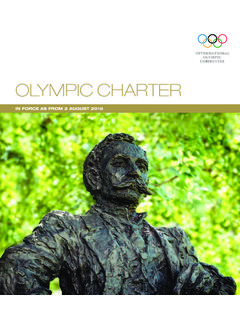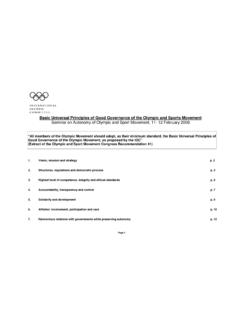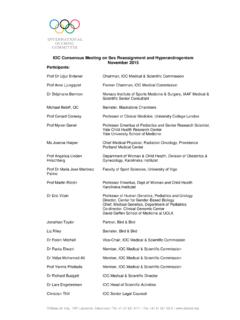Transcription of Olympism and the Olympic mOvement
1 Olympism and the Olympic mOvement Olympism and the Olympic What is Olympism ? The Olympic mOvement : Activities outside mOvement A philosophy of life. how does it work? the Games An ideal: the combination The structure of the Olympic Actions on various fronts of sport, culture and education. mOvement : the International 365 days a year: Sport for All, Olympic Committee (IOC), development through sport;. Olympic values. the National Olympic Committees equal opportunities; education Olympic symbol and other (NOCs), the International and culture; sport for peace, identifying elements . Sports Federations (IFs) the environment and sustainable and the Organising Committees development; protecting for the Olympic Games (OCOGs).
2 The health of athletes; combating illegal sports betting. 3 7 11. Historical milestones Creation of the IOC in 1894. in Paris (France), on the initiative of Pierre de Coubertin. The eight presidents over a century. The IOC headquarters, This is a PDF interactive file. The headings of each page contain hyperlinks, which allow to move from chapter to chapter. in Lausanne (Switzerland). since 1915. Click on this icon to download the image . Cover: OG London 2012, Opening Ceremony Entry of the Olympic flag into the stadium. 2012 / International Olympic Committee (IOC) / JUILLIART, Richard 15. Olympism and the Olympic mOvement What is Olympism ? 3. What is Olympism ? 1. OG London 2012.
3 Athletics, 5000m Men Qualifications. Mohamed FARAH (GBR) 1st congratulates Ren Herrera (PHI). Olympism is a philosophy of life which places sport at the service at the end of the race. 2012 / International Olympic of humanity. This philosophy is based on the interaction of the qualities Committee (IOC) / FURLONG, of the body, will and mind. Olympism is expressed through actions which Christopher link sport to culture and education. This philosophy is an essential element of the Olympic mOvement and the celebration of the Games. It is also what makes them unique. The pursuit of this ideal and the other fundamental principles of Olympism . [set out in the Olympic Charter] gives rise to a series of values, which are applicable both on the field of play and in everyday life.
4 The IOC has identified the following three Olympic values: Excellence In the Olympic ideal, this value refers to giving one's best, on the field of play or in life, without measuring oneself with others, but above all aiming at reaching one's personal objectives with determination in the effort. It is not only about winning, but mainly about participating, making progress against personal goals, striving to be and to do our best in our daily lives and benefiting from the combination of a strong body, will and mind. Friendship Men and women are at the centre of the Olympic mOvement 's focus encouraging the links and mutual understanding between people. This value broadly refers to building a peaceful and better world through solidarity, team spirit, joy and optimism in sport.
5 The Olympic Games inspire humanity to overcome political, economic, gender, racial or religious differences and forge friendships in spite of those differences. The athletes express this value by forming life-long bonds with their team-mates, as well as their opponents. Respect In the Olympic ideal, this value represents the ethical principle that should inspire all who participate in the Olympic programmes. It includes respect for oneself and one's body, respect for one another, for rules and for the environment. It thus refers to the fair play that each athlete has to display 1 in sport, as well as avoiding doping. The Olympic Museum Olympism and the Olympic mOvement What is Olympism ?
6 4. It was also Pierre de Coubertin who had the idea of an Olympic flag. He presented These values are powerfully conveyed at the time of the Olympic Games. However, between editions of the Games, the Olympic mOvement continues 1. 2002 /Getty Images News and Sport the rings and the flag in June 1914 in Paris, to be spread through the ongoing work of the members of the Olympic family. at the Olympic Congress. But as the First The values and meaning of Olympism are expressed by the Olympic symbol (the five rings) and other identifying Olympic elements (the flame, the torch relay, World War prevented the Games from the motto, the maxim, the anthem and the oaths). These make it possible to transmit a message simply and directly.
7 They give the Olympic mOvement being celebrated as planned in Berlin and the Games their own identity. in 1916, it was not until 1920 at the Games It was Baron Pierre de Coubertin who revived the Games. Born in 1863, he devoted his life to the reform of education and youth in France. Fascinated by the English in Antwerp that the flag with its five rings education system, which included sport in the teaching programme (a new idea at the time), he sought to convince was flown in an Olympic stadium for his contemporaries in France that sport could be beneficial for young people. Not everyone shared this view, and so the first time. Coubertin looked for a way to make people change their views.
8 That was when he had an idea: to revive the Olympic Games. While this was not the first attempt to revive the Games, Coubertin brought a modern and international dimension and succeeded in re-establishing them. But for him, the Games were not an end in themselves. Rather they were part of a much broader project: education through sport. The Olympic symbol: the five rings A very powerful symbol, the five rings are the visual representation of Olympism . It was Pierre de Coubertin himself who designed the symbol. The five rings represent the five continents. They are interlinked to show the universality of Olympism and how athletes from all over the world come together for the Olympic Games.
9 On the Olympic flag, the rings appear against a white background. Combined in this way, the six colours of the flag (blue, yellow, black, green, red and white) represent all the nations. It is therefore not the case that each of the colours is associated with a particular continent. Today, the symbol is one of the most widely recognised in the world. Its use is subject to very strict rules enacted by the IOC. It is important to note that there is just one Olympic symbol. For the other identifying elements described below, other terms are needed. 1 The Olympic Museum Olympism and the Olympic mOvement What is Olympism ? 5. L'important dans la vie n'est pas de vaincre mais de lutter.
10 Other elements of the Olympic identity: 1. The Olympic Flame is passed The flame and torch relay between torches L'essentiel n'est pas d'avoir gagn mais (see The Olympic flame and the Torch Relay ]. Getty Images With the flag, the Olympic flame and torch relay are the most well-known de s' tre battu. elements of the Games. At the modern Games, the Olympic flame is an expression of the positive values that human beings have always associated with the symbolism of fire. The flame is lit at Olympia in Greece, recalling the Ancient Greek roots of the Olympic Games and also emphasising the link between the ancient and modern Games. From Olympia, the flame is carried to the city hosting the Games by thousands of torchbearers.)
















